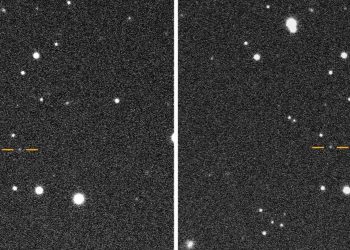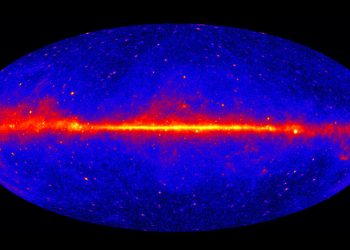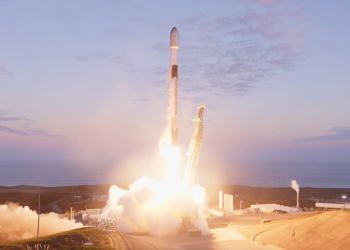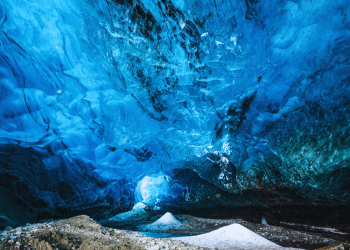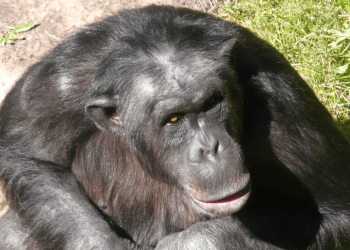New images of the interstellar object 3I/ATLAS, taken by the 2.5 meter Nordic Optical Telescope in the Canary Islands, Spain (accessible here), reveal that the anti-tail of 3I/ATLAS towards the Sun observed in July and August 2025 turned into a tail in September 2025. No terrestrial observations are possible during the month of October because 3I/ATLAS arrived too close of the Sun in the sky.
The mass loss rate inferred from 3I/ATLAS scales approximately with the flux of solar radiation striking its surface. The authors, David Jewitt and Jane Luu, note that this dependence is consistent with carbon dioxide (CO2) being the primary driver of activity, as already inferred from previous spectroscopic data from the SPHEREx space observatory and the Webb Space Telescope (reported here and here, respectively). The exquisite spectrum measured by the Webb telescope (reported here) implied a mass loss rate of about 150 kilograms per second at a distance of 3.32 times the Earth-Sun separation (au), with a mass composition of 87% CO2, 9% CO, and about 4% H2O.
High-resolution 3I/ATLAS imaging taken by the Hubble Space Telescope on July 21, 2025 (as shown here) revealed a pronounced anti-tail toward the sun with a projected aspect ratio of 2:1 and a view-angle corrected aspect ratio of approximately 10:1 in three dimensions – resembling a jet. In collaboration with Eric Keto, I wrote an article (accessible here) explaining this jet towards the sun as being dominated by the scattering of sunlight by fragments of H2O ice ejected from the core of 3I/ATLAS following the sublimation of CO2.
Today, Eric Keto and I published a detailed theoretical model (accessible here) that explains the transition of the 3I/ATLAS anti-tail to a tail in September 2025. In addition to the Nordic optical telescopes, observations with the Keck telescope (reported here) and the Gemini South Observatory (reported here) show a reduction in the anti-tail and the growth of a tail in a direction opposite to the Sun. Our model details the physics behind this evolution. As 3I/ATLAS approaches the Sun, the exponential dependence of the sublimation rate on temperature causes a continuous increase in the production rate of ice fragments and a sharp decrease in their residence time in the flow. The combined effects produce a peak in the total scattering cross section due to H2O ice grains at a distance of 3 to 4 au from the Sun. At closer heliocentric distances, diffusion is dominated by longer-lived refractory dust particles and larger volatile grains with survival times long enough to form a tail that moves away from the Sun.
Images taken on October 2, 2025 by the HiRISE camera on board Mars Reconnaissance Orbiter (still unavailable, possibly due to the US government shutdown) are expected to provide a side view of the glow around 3I/ATLAS with a pixel resolution of 30 kilometers. Once published, they would provide an excellent test for the Keto-Loeb model of an icy coma around 3I/ATLAS.
The total amount of mass lost by 3I/ATLAS during the months of July to October 2025 is approximately 2 million tonnes. This equates to a fraction of less than 0.00005 of the total mass of 3I/ATLAS. The interstellar object was inferred to have a mass greater than 33 billion tons based on the absence of detectable non-gravitational recoil in its trajectory, as suggested in a paper I wrote in collaboration with Richard Cloete and Peter Veres (available here). The entire gas plume around 3I/ATLAS requires the ablation of a surface layer with an average thickness of only 4 centimeters from a solid object with a diameter of 5 kilometers, comparable to the ratio of the length of the palm of the hand to the length of the island of Manhattan. Needless to say, we cannot deduce the true nature of 3I/ATLAS from the layer of skin he has lost so far.
My colleague, Adam Hibberd, pointed out that if the object is an alien spacecraft that is slowing down and the anti-tail is braking the thrust, then this change from anti-tail to tail would be entirely expected near perihelion. In this case, the transition would constitute a technosignature in the form of an unexpected phenomenon indicating a controlled maneuver, possibly with the aim of achieving a heliocentric orbit linked between the orbits of Mars and Jupiter.
Since the surface of 3I/ATLAS will be exposed to at least 33 gigawatts of solar radiation at perihelion, post-perihelion observations at its closest approach to Earth on December 19, 2025 will provide the most important clues to its nature. If, following intense solar heating, 3I/ATLAS presents all the characteristics of a natural comet, I will reduce its rank to 2 on the global scale. Loeb scale (quantified here and here). The rank will not go down to 0 because the enormously greater mass of 3I/ATLAS compared to 1I/`Oumuamua and 2I/Borisov and its precise orbital alignment with the plane of the ecliptic will never disappear.
ABOUT THE AUTHOR
Avi Loeb is the leader of the Galileo Project, founding director of the Black Hole Initiative at Harvard University, director of the Institute for Theory and Computation at the Harvard-Smithsonian Center for Astrophysics, and former chair of the Department of Astronomy at Harvard University (2011-2020). He is a former member of the President’s Council of Advisors on Science and Technology and former chairman of the Council on Physics and Astronomy of the National Academies. He is the bestselling author of “Alien: The first sign of intelligent life beyond Earth» and co-author of the manual «Life in the cosmos», both published in 2021. The pocket edition of his new book, entitled “Interstellar», was published in August 2024.



